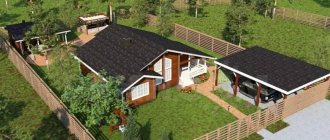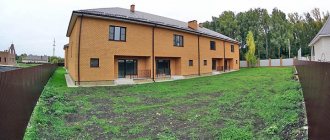Didn't find the answer to your question? Find out how to solve exactly your problem - call right now: +7 (Moscow) +7 (St. Petersburg) It's fast and free!
All lands in our country have a certain category. In this regard, a specific site can be used only within the framework specified by law.
The use of an object for other purposes and the erection of a structure on it that is not intended for the same purpose as the category of land is unacceptable.
Quite a lot of owners are interested in whether it is possible to build a house used for regular living on gardening land?
What are SNT lands intended for?
SNT lands are allocated to citizens from agricultural lands or from the lands of a populated area. The allocated land must be used for growing horticultural crops. The buildings erected on the site should facilitate this process. In this case, a building permit is not needed, and a special project is also not required.
Note!
The legislation does not clearly implement the separation between commercial and residential buildings. To store equipment, you can build either a small shed or a mansion. Initially, you only need to consult with the architectural department about the size and height of the building.
Difficulties will arise in the process of registering the building and registering in it. In 2011, the Constitutional Court decided on the possibility of exercising the right to build and add to it, subject to two conditions:
- the house must be given the status of a residential premises, i.e. you can live in it all year round;
- the owner of a plot in SNT should not be the owner of other real estate where registration can be issued.
Land for summer cottage construction
Dacha plots are lands that have “Summer dacha management” as the type of permitted land use.
In accordance with the classifier approved by Order No. 540, a dacha plot involves the following types of activities:
- Construction of a residential building of no more than 3 floors;
- Construction of outbuildings;
- Growing crops.
Dacha plots belong to the category of land in populated areas. Construction on such lands is regulated by the Town Planning Code of the Russian Federation. According to paragraphs. 3.9 tbsp. 35 of the Civil Code of the Russian Federation, dacha farming can be carried out in residential and agricultural zones belonging to the lands of populated areas.
Status of the site and the possibility of construction on it
It is possible to build a house, recognize it as residential and register in it only if the site has the status of farmland and is located on settlement land. Having previously determined the area where the site is located, you can legitimize the construction of the house.
You are advised by the best qualified lawyers
Free: Our lawyers provide free initial consultation on any legal issues. 90% of cases are resolved with one free consultation.
Around the clock: for real estate in an online chat, or use the forms on the website
Any settlement, according to town planning regulations, has residential, business, industrial and other zones. If SNT belongs to a residential area, there is no need to find out the possibility of building a house. You should immediately contact your local administration with a request.
Note!
The application is reviewed within 1.5–2 months. If the decision is positive, you can begin construction and subsequently register in it.
This option can only be used if the site is an independent object, registered and in sole ownership.
If the SNT has common land, and each participant has only a share in it, then you must first obtain data on the standards that are accepted in gardening. This information is found in the constituent documents. gardening.
SNT must have a formal site development plan, which is approved by the local authorities. It contains:
- permissible height of buildings;
- material from which to build;
- various building codes.
The established standards are mandatory for everyone. In case of deviation from them, this will be considered as a violation of contractual relations with the partnership or cooperative.
How to change the category or purpose of land?
Such issues are dealt with exclusively by the local administration. The owner must contact the department at the location of the site with the following documents:
- passport;
- a statement containing a request to change the designated purpose of the territory;
- title papers for land;
- an extract from the Unified State Register containing characteristics of the site;
- territory planning project;
- a diagram of the location of the object (to accurately determine its location);
- power of attorney certified by a notary (if necessary).
It is recommended to check the list with an administration employee, as it may differ depending on the situation. After the application is accepted, the citizen is given a corresponding receipt containing the date of the person’s application and a list of papers provided by him.
The time frame for consideration of this issue does not exceed one month, since public hearings are not required when obtaining a housing construction permit.
The difficulty of changing the category of a site lies in the fact that the lands allocated for gardening have higher soil fertility, which cannot be said about the territory that is part of the lands of populated areas.
In order for the administration to allow the transfer of a site from one category to another, the interested party must prove that the quality of the soil has changed significantly for the worse, or find another basis for applying to the municipality.
At the end of the process of studying the case, the head of the administration makes the appropriate decision:
- on satisfaction of the applicant's requirements;
- on refusal to change the category or intended purpose of the land.
A negative decision by the administration can be appealed to a higher authority. If a positive decision is made on the case, changes to the USRN database will be made automatically after 15 days.
A citizen has the right to independently contact Rosreestr with a conclusion from the administration and an application to enter new information into a unified data register.
What is needed to build a house in SNT
To build or reconstruct a house you need to have a special building permit. But based on the Town Planning Code, permission is not required for the construction of buildings on garden plots. Only to transfer it to a residential property will require special permission. To obtain it, you should contact the authorities involved in urban planning with the following documents:
- confirming the right of authority;
- urban planning plan;
- plan of the land plot with designation of the building site.
After approval, construction work can begin.
The law also stipulates what kind of house can be built on the site. The number of floors is no more than three, and the height of the entire building is no more than 20 meters. The house should not be divided into apartments. This norm was introduced to prevent the construction of apartment buildings and townhouses on land plots. Once construction is completed, a notification is sent to the municipality.
Note!
If a house that has not been registered exists or was completed before 03/01/2019, for its registration you will only need a technical plan and a declaration.
Can it be used for gardening?
Article 7 of the Land Code of the Russian Federation provides a list of established categories of land, where lands of settlements and lands for agricultural purposes belong to different categories. However, both categories allow the use of land for gardening purposes.
This fact is enshrined in legislation by the following acts:
- Town Planning Code.
- Federal Law No. 136-FZ dated October 25, 2001 – Land Code (LK) of the Russian Federation.
- Federal Law No. 101-FZ dated July 24, 2002 – on the turnover of agricultural land.
- Federal Law No. 66-FZ dated April 15, 1998 and No. 99-FZ dated May 4, 2011 - on dacha non-profit organizations.
- Federal Law No. 7-FZ dated January 12, 1996 – on non-profit organizations.
Various regulations for the construction of permanent buildings are indicated here, as well as differences in the development of infrastructure and the installation of utilities. All permitted actions are indicated in the document approved by Order of the Ministry of Economic Development No. 709 dated September 30, 2015 (VRI Classifier). According to the Classifier, arrays of different categories have different purposes.
In this case, the differences are as follows:
- Settlement lands can be used by citizens: for individual housing construction (IHC), for personal subsidiary plots (LPH).
- Agricultural lands: for private household plots, for non-profit associations (NPOs) of gardeners; for peasant farms (peasant farms).
Reference: NPOs of gardeners include dacha settlements in garden non-profit partnerships (SNT), dacha non-profit partnerships (DNT), dacha non-profit partnerships (DNP).
What kind of houses can be built on a gardening plot?
According to the law, on land allocated for gardening, all buildings, paths, etc. should occupy no more than ¼ of the area. The intended purpose of the buildings must be respected. Therefore, the size of a residential building depends on the size of the plot.
Construction must comply with SNiP standards, which stipulate the distance between sections:
- from a residential building – 3m;
- from sheds, buildings where animals are kept - 4m;
- from auxiliary buildings – 1m.
Note!
In addition to the norms established by the state, there are SNT norms. They can increase the norms over distances or decrease them. However, it is not recommended to reduce the distance to places where animals are kept, a cesspool, or a bathhouse.
The owners of neighboring plots may present demands for the elimination of violated standards. If violations are not eliminated voluntarily, the issue is resolved in court. The court may support the demands and order the house to be moved or demolished completely.
Basic rules for the location of buildings on a garden plot
SNiP 30-02-97 established that when erecting buildings on a plot of land, the following minimum distances must be observed to the boundary boundaries of a neighbor’s plot:
- the house must be no closer than three meters, counting from the nearest wall or part of the house protruding more than 50 cm from it;
- poultry house, barn, stable and other premises for animals - 4 meters;
- other outbuildings and buildings – 1 meter.
The required gap between structures and buildings on the site (and on neighboring sites as well) to the outdoor toilet and buildings for animals and poultry, compost heap:
- from the house and cellar - at least 12 meters,
- from the bathhouse (shower), respectively, at a distance of 8 meters;
- from the well - 8 meters.
Important! Whether it is possible to build a house on land for gardening near neighboring buildings is specified in the statutory documents of SNT. Organizations sometimes have their own standards additional to SNiP, as well as some relaxations of the standards.
Failure to comply with individual points of the regulations may not entail a requirement to demolish a permanent structure, but the owner may be required to eliminate the violation or move light structures.
Buildings and paths on the territory of the garden plot should not occupy more than 25% of the territory.
It should not be forgotten that the purposes for which the land was intended were at least partially achieved on the site.
What responsibility awaits violators?
Before starting construction, you must definitely find out the question: is it possible. You can immediately begin transferring the land to another category or first build a house and then convert it into residential premises. But in all cases, the house must be registered.
If a house is erected without permission, it must be demolished at the owner's expense. This decision is made in court if:
- The land plot is not the property of the owner of the building.
- As a result of construction, the rights of neighbors were violated. For example, the amount of natural light has decreased.
- During construction work, violations were committed that made the house dangerous for other people and the environment;
Sometimes the court decides to move the building or reduce its size. To prevent this from happening, you should worry about a building permit in advance and find out what can be built on your site.
Note!
A refusal to build can always be appealed in court.
Differences between agricultural storage units and individual farms
From the category of settlement lands, we can distinguish land plots suitable for gardening and horticulture - plots for private household plots, where you can run an individual farm. Agricultural lands allow that tracts intended for private household plots, non-profit organizations and peasant farms can be used for the purposes under consideration.
The main difference between them is the location of the array:
- within the boundaries of the settlement, with zoning for private household plots;
- beyond its boundaries, where agricultural lands begin (clause 1 of Article 77 of the Land Code of the Russian Federation).
From this difference arise the following distinctive features, based on the norms of legislation that regulate land relations and establish regulations for the use of plots:
- The lands of the settlements provide for the development of infrastructure, installation of utilities, and highways. The formation of a legal entity is not provided.
- Agricultural lands are located in ecologically clean areas where linear facilities, utilities and developed infrastructure are not provided. The formation of a legal entity is mandatory.
- The cadastral value of settlement lands is higher than agricultural plots, and accordingly the land tax is higher.
That is, inclusion in the city provides advantages in the form of proximity to the city’s infrastructure, more convenient access to the site and ease of installation of utilities, but such land plots remain on their own, unlike holiday villages.
Features of the allocation of land in settlements
The procedure for allocating a plot of land for the construction of a private house on the territory of a populated area is a difficult and long process, during which several important nuances must be resolved. To obtain permission you will need to adhere to the following algorithm of actions:
- The desired land must have all the required documentation. This is possible if the territory belongs to an individual or legal entity, partnership or several persons at the same time.
The main document is the Certificate of Land Title
See also: Popular plots in the Moscow region for the construction of a country house.
- It is necessary to send an application to the administration regarding the use of land for the construction of permanent housing without changing its category. The review is carried out by the head of the district or subject.
- The result of consideration of the application is the appointment of a date for public hearings. At public hearings, all interested parties are present and receive information about the resolution of the issue regarding the site through the media. During the procedure, the likelihood of changing the type of a certain piece of land for further use for the purposes specified in the appeal to the head of administration is decided.
- When the time comes for the hearing, the administration selects one of those present as a secretary to draw up the minutes necessary to record the issues considered and the personal information of the interested parties who came. After completion of the hearings, the drawn up document is certified by the chairman of the commission.
- Within one week, each person present at the hearing receives a conclusion on the results of the review. Before publication in the media, the document is certified by the district administration.
They can allow summer cottage construction in a populated area, but this does not always happen quickly
- Transfer of documentation to Rosnedvizhimost. The body is undertaking a number of activities to change the way land is used. The longest part of the procedure, since the applicant is required to wait for a long time to resolve all issues. The completion of changing the type of plot is the issuance to the owner of an act of determining the cadastral value.
- The received documents are sent to Rosnedvizhimost to change the type of cadastral registration based on the received act of determining the value. If the decision is satisfactory, an extract is issued confirming the change in the type of land.
- Now the owner can receive a certificate of ownership, which will indicate the new purpose for using the land.
After this, the land owner can proceed to the construction process, which will require equipping the site in accordance with all requirements, one of which is connecting communication systems.
Free land
The allocation of land plots for housing construction can be done free of charge. There are categories of citizens to whom land within the boundaries of a populated area is given for free:
- large families with three or more children;
- families with disabled children;
- veterans of the Great Patriotic War and labor;
- Heroes of the USSR and Russia;
- Knights of the Order of Glory;
- citizens registered in the village and living there for more than 5 years;
- people who suffered from repression;
- families of heroes who died in the line of military duty.
This list can be expanded in each subject of the Russian Federation at the discretion of local authorities. You can receive a plot of land free of charge for building a house only once.
It is possible for every Russian citizen over 18 years old to receive free land. This is the so-called Far Eastern hectare. It is allocated in a certain territory of the Far East to anyone who expresses a desire to receive it.
Definition and Features
Collective gardening is a special form of public use of land, which is carried out by citizens who own plots of land through their association into special partnerships - organizations of gardeners.
Such an association always arises on a voluntary basis and is necessary to solve significant socio-economic problems in the process of conducting gardening activities. For example, such as the development of roads, water supply systems, sewerage systems and other tasks that are difficult for owners to solve on their own.
As the legal form of such an association, citizens can choose a non-profit partnership (or SNT), partnership and cooperative.











